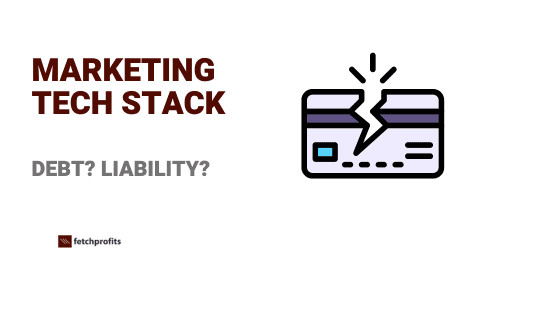I know, that’s quite a mouthful. But it’s a mouthful of unhinged debt, if you don’t think about it.
I once wrote about the problem with your marketing tech stack (maybe you don’t see that yet?).
Marketing Tech Stack Debt — is the total amount of cash you pay monthly or yearly — for the sum total of all the marketing tools (not including any other apps, software, and tools you could be using).
Here’s shocking truth: Your customers don’t care about your marketing tech stack; all that they care about is how they “feel” about doing business with you.
The customer doesn’t care about your hardware, software, and deployment details. They just want to know that they can get their problem solved or will receive the service they are expecting on time (or sooner).
There’s a lot to benefit from at the intersection of business and technology. Businesses stand to gain from digital enablement, digital transformation, refined business processes, faster turnaround time, cheaper and more efficient production
Meanwhile, my friends at Creators Virtual Solutions have an interesting take on all of these marketing tools that you have to stitch to make it work (“all held together by prayer and manual data entry”)
Your tech stack looks like a digital junkyard: 17 different tools that hate each other, held together by prayer and manual data entry.
— Creators Virtual Solutions 💻✨ (@CreatorsVirtual) August 27, 2025
You're not leveraging technology. You're being held hostage by it.
Plot twist: The problem isn't your tools. It's your strategy. 🧵
Marketing Tech Stack Debt: Too Much already, more to come
Just a few years ago, it was just tools (al sorts of them). Now, it’s legacy tools with some sort of Generative AI thrown in, added-on, bolted in, and latched on. As if that wasn’t enough, we now have purely AI-driven tools (most of them are wrappers — delivering what they promise (and doing it well, hopefully).
The trouble isn’t as much about the tools themselves (I love them and you love them too). It’s only the disparate, roughly strewn about, ecosystem-less promise that these marketing tech tools present to us as business owners.
More specific points below but the main premise is the absolutely wild things you now have to think about, choose from, decide on, and commit to.
Some tools are built separate for each platform you are on — say for Shopify, for WordPress, for Webflow, and so on
- Email marketing tools or platforms,
- eCommerce Checkout optimization tools, Apps for Shopify, and plugins for WordPress
- Lead generation tools,
- Analytics tools,
- Competitor Analytics tools
- Landing page software,
- Marketing automation platforms,
- Referral marketing platforms
- Affiliate marketing tools and platforms
- eCommerce management tools: These include “things made for little things” such as a plugin for displaying currencies depending on where your customers are located. Or another plugin to help optimize speed, and so on.
Do you see where I I am going with this? Let’s say you pick and choose from the lot
The Integration Wild Wild West
Chances are that you could be using some marketing tools already, if it’s been a while you’ve been in business. You’d be using some sort of marketing tech stack
Go to any of the home pages of any of the marketing tools you are considering and click on “integrations”. What do you find? Do you see any of your existing marketing tools integrating with the specific tool you are considering at the moment?
Chances are that you might not.
Example: WordPress Integrates with Klaviyo (WooCommerce native integration). Klaviyo also integrates straight away with Meta lead ads, and other Meta campaigns. The combination of these becomes your marketing tech stack.
If you are on Shopify, it’s still good news as far as Klaviyo and Shopify go. Klaviyo has direct integrations with Shopify (and this enables tracking of all sorts — purchases, orders, newsletter sign-ups). You can also float automations, abandoned cart emails (automated), browse abandonment flows, and more.
But let’s say you heard about just how awesome and promising Webflow route is, especially if you wanted to try Headless eCommerce. So, does Klaviyo integrate with Webflow? Not straightforward enough. Not native enough. It can still be done though.
Maybe you can stitch, slap, and duct-tape a few of these marketing tools together with Make, Zapier, or N8N. That’s another set of tools with subscription payments you didn’t see coming now, did you?
Data Mismatch Horror Stories
Pete Caputa, CEO of Databox, recently did a podcast titled “Predictable Scale: The 6-Step System To Drive Consistent, Sustainable Growth”
Quoting him verbatim
The frustration that I’m both feeling and hearing is that it feels like we’re almost working twice as hard to get half as far these days. And there’s two reactions to that: One is ‘it is what it is’ and we just keep working as hard as we can. Or we can focus in on the things that will have the most impact on our business — and ignore the rest. ~ Pete Caputa, CEO, Databox
In the post, Pete talks about his SPEARS framework and chalks out specific leverage points for scaling (which we aren’t getting into, in this post).
However, here’s what I wanted to highlight:
Each of the tools in your marketing tech stack enables flow of data (from one tool to another). But you won’t see much, let alone do anything about it.
The state of small businesses is that not everyone has access to, or sees, or has a way to utilize data. but:
Data only drives action if everyone can see it.
Also,
“More than 50% of companies don’t share beyond the manager level. What that does is disempower the rest of the organization from having ideas, helping each other, or even caring about their own performance.”
That’s why tools like Databox makes it easy to pull in data to help businesses work with a Business Intelligence Dashboard. All the data — including metrics, KPIs, conversions, newsletter subscriptions, purchases, orders, and sales flow into singular dashboards that everyone has access to. Other options for you, for this specific aspect without getting too fancy with PowerBI and others, are Coupler.io and Supermetrics
Pete also wrote a hard-hitting LinkedIn post on the horror of businesses “unable” to use all of the data pouring in for the marketing efforts these businesses break their collective backs for.
What’s the way out of this mess, apart from Pete’s insights, applied to your marketing tools and your tech stack, you ask?
According to Jack Van Gills of Reconext
Make an organization-wide, consistent decision to be data-driven. Second, add people and resources towards that project of creating and moving to that world, so that you’ll keep doing it for months and years.
The Potential Of Your Marketing Tech Stack
Your marketing tech stack has the potential to bring in real results for your business. You now have the ability to do more than you could ever dream of, with much less.
At the age where AI intersects legacy technology and where “AI-driven” everything seems to be the norm (or will be?), the costs for orchestrating holistic marketing efforts (across the board — from content marketing to email marketing, from lead generation to paid advertising) are much less now.
Of course, the cost of acquiring customers is going way up (that’s a topic for another day).
So, how do you deal with this persistent issue of new tools trying to make their way into your marketing tech stack? How do you handle making decisions for these? What should you do before you decide?
Get that cup of coffee and sit down to think hard about what you really need just to get a healthy start. I didn’t say “free start” and I didn’t say “cut the corners and start cheap”. Think about running your business the way middle-class families that are perennially tight on budgets think: What’s absolutely essential? What do we need to bring in X,Y,Z results?
- Categorise needs and wants: No, this isn’t a personal finance blog but stay with me: Let’s say you run an eCommerce business. What do you need? Choose one from below
- Dependable, reliable, and robust eCommerce platform. Choose WordPress, Shopify, or Webflow eCommerce.
- You then need a way to do marketing — you need content marketing and a presence on social media (you can do eCommerce blogging for all three platforms and social is social).
- Generate leads with Unbounce, Instapage, Or LeadPages (LinkedIn Ad forms or Meta Ads Leads — are native to each of these respective platforms)
- You then need email marketing (which brings in the money). You can use any email marketing platform such as Klaviyo, MailerLite, MailChimp, MooSend, and tons of other newer email marketing platforms — doesn’t matter, as long as you have an active program and you are committed to make email marketing work for you.
- Analytics (apart from Google Analytics and platform-specific analytics like Shopify analytics): Get Databox, Supermetrics, or Coupler.io
- One single platform for eCommerce support, say Gorgias.
Think of the bare minimum you need to start, run, and manage your business. Don’t rush in and buy all sorts of tools just because you see slick home pages.
You can always get to them later.
That’s it. Every other decision comes in later. I’d go so far as to say that you don’t think of investing anything on any other tool for your marketing stack until you have a dollar in profit to show for that potential investment.
How do you handle your marketing stack decisions? What do you do to prevent yourself from getting into Marketing Tech Stack debt?

